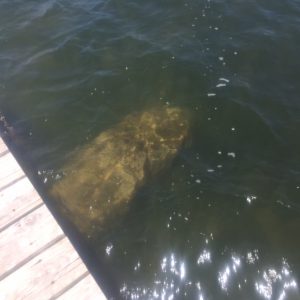On May 7, 2017 Marsha Stanton spotted a manatee swimming by her pier in Big Lagoon near Pensacola. I am sure this was an exciting moment and Marsha was interested in letting someone know so that the unusual encounter could be logged.

Photo: Marsha Stanton
There are four species of manatee in the world; the West Indian Manatee (Trichechus manatus) is the one native to the South Atlantic, Caribbean, and Gulf region. The Florida Manatee (T. manatus latirostris) is a subspecies that is found in Florida. The historic range of the Florida Manatee included all of the Gulf coast and the east coast as far as the Chesapeake Bay. However, the increase in humans triggered a decrease in manatees. In the 1970’s it was rare to find the animal outside of the Florida peninsula.
Florida first began protecting the animal in 1893 and today it is protected by the state with the Manatee Sanctuary Act, the federal Marine Mammal Protection Act, and the federal Endangered Species Act. In the 1970’s the population of Florida Manatees was estimated to be about 1000 animals, today there are an estimated 6000. Due to the increase throughout its range, the animal has now been moved from ENDANGERED to THREATENED. In 2016, 521 manatee deaths were logged with FWC. The average for a month was 43. The majority of these were logged as unknown or perinatal (associated with the weeks before and after birth) and the highest for a month was in February. Boat strikes were logged as the largest problem for the months of January and July.
All that said, we would certainly like to protect any manatee that visit’s our area. So what can we do?
- If boating, use the marked channels. There is evidence that manatees try to avoid boat traffic by staying out of the boating areas.
- If you must leave the channel to reach your dock or the beach do so at idol speed. Wear polarized glasses and have a look out. Manatees do not break the surface as dolphins do, rather they generate “swirling eddies” as they move beneath the surface. So slow your movement and have a watchful eye and we can help reduce problems.
- If snorkeling, diving, or swimming near a manatee do not approach the animal; this can be stressful for them and could be reported as harassment by FWC; which could come with a fine. Allow the animal to move as it wishes and enjoy the experience.
- The same goes for a kayak or paddle encounter. Do not chase the manatee or separate mother from calf.
- Another issue has been feeding manatees or providing them freshwater from a hose. This practice has gone on a long time but researchers now know that this decreases the fear of humans by manatees and they return. This can cause boat strikes to increase. It is also considered harassment.
Marsha was interested in letting researchers know about this unusual encounter. However, researchers, and FWC, do not necessarily consider this as unusual as we think. Manatees have become a main stay at Wakulla Springs State Park during the colder months and are common enough in the Mobile Bay area that a manatee watch program has been developed. If the animal is distressed, injured, or you find a dead one you can report this to FWC at (888) 404-3922. If the animal is fine, healthy, and swimming just follow the basic rules listed above and enjoy a really cool experience with this really cool Floridian.
More information on “do’s” and “don’ts” can be found at
http://myfwc.com/education/wildlife/manatee/viewing-guidelines/.
http://myfwc.com/media/415226/manatee_fltreasure_bklt.pdf
 0
0
